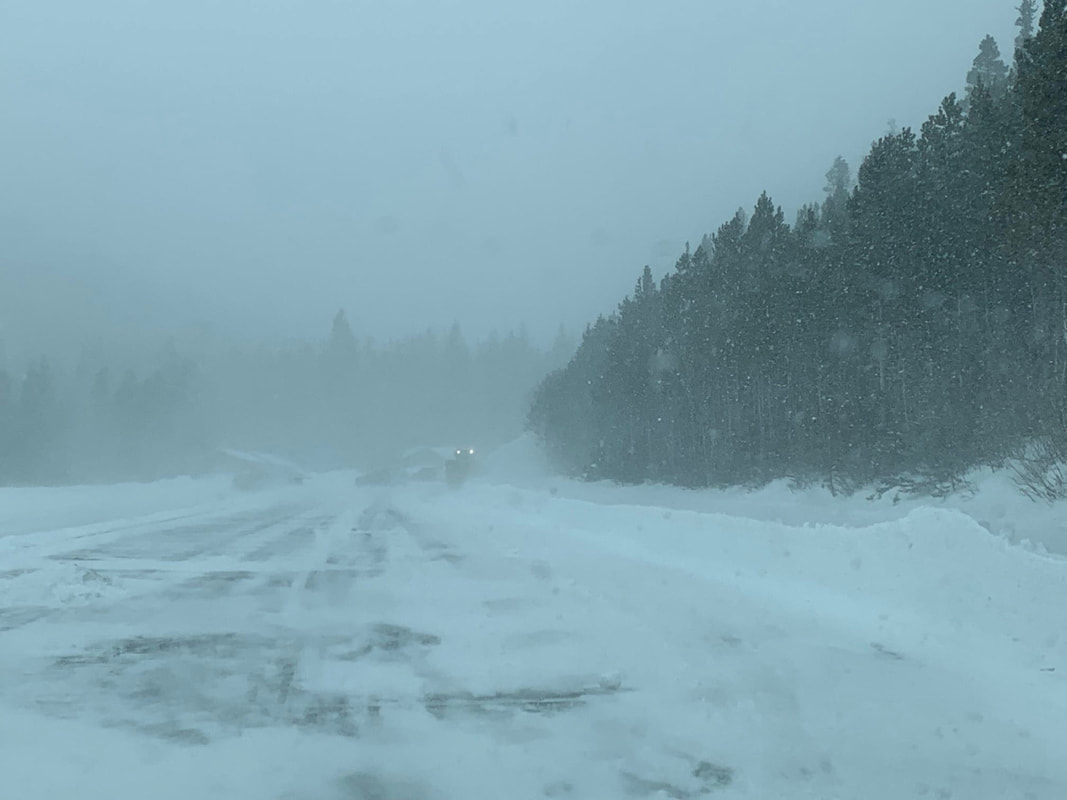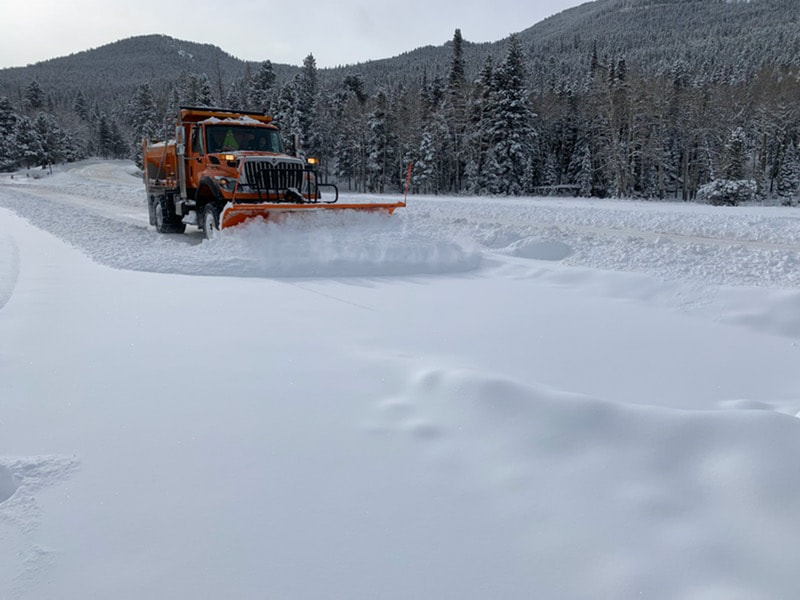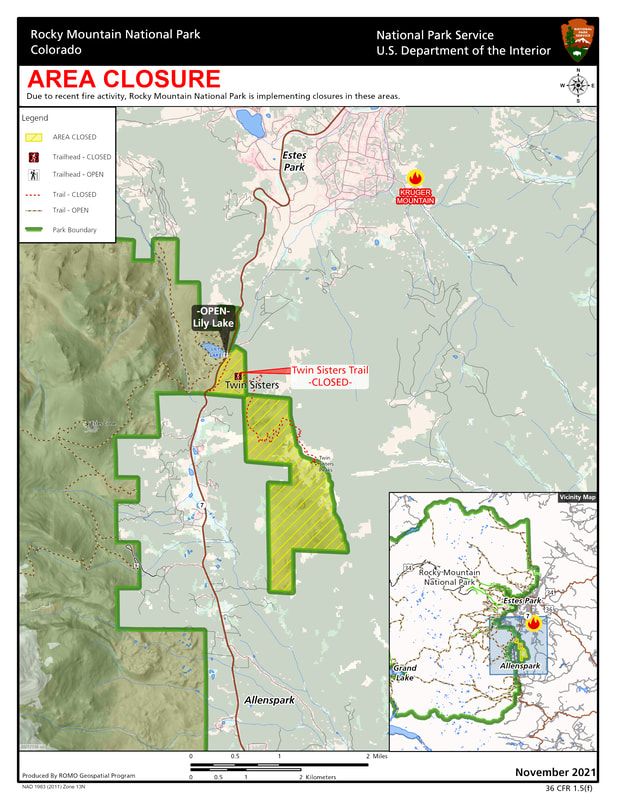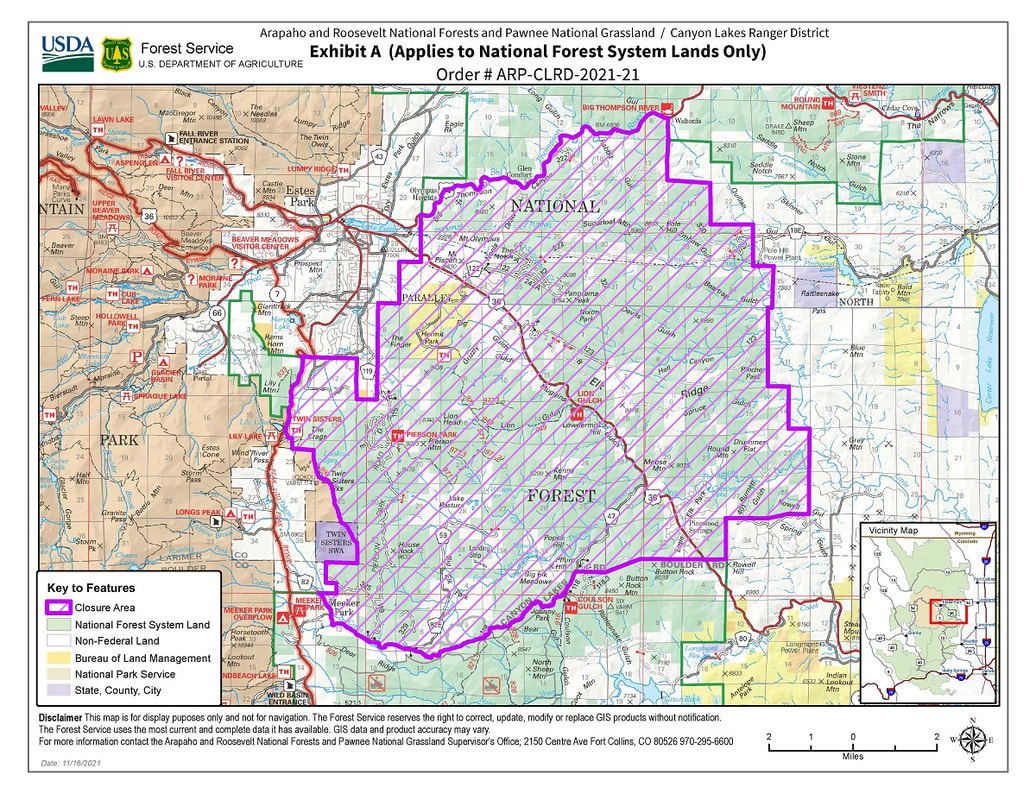|
RMNP UPDATE: January 8, 2022, 2:57 pm US 36 at the Beaver Meadows Entrance on the east side of Rocky Mountain National Park is now open to vehicles. Trail Ridge Road is open to Many Parks Curve with access to the Hidden Valley area. Bear Lake Road is open to Sprague Lake and is closed beyond Sprague Lake to Bear Lake for continued snow removal operations.
US 34 at the Fall River Entrance to Deer Ridge Junction and Wild Basin Road remains closed to vehicles. Four wheel drive and all wheel drive vehicles are advised.
0 Comments
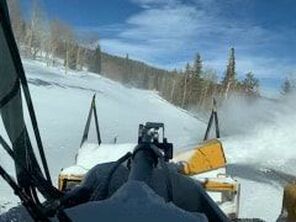 Plowing efforts in RMNP along Bear Lake Road January 7 2022 / Photo Courtesy RMNP Plowing efforts in RMNP along Bear Lake Road January 7 2022 / Photo Courtesy RMNP RMNP UPDATE - January 8, 2022, 9:09 AM Please note - photograph was taken yesterday, January 8, on Bear Lake Road when there was blue sky. It's currently snowing in that location this morning. Drifting snow caused by significant wind during and after the recent snowstorm continues to cause challenging conditions on the east side of Rocky Mountain National Park. This morning, snow and wind at higher elevations are again hampering efforts. Park snowplow operators are encountering drifts from 6 to 12 feet along sections of park roads above 8,500 feet. A drift above Hollowell Park, along Bear Lake Road at approximately 9,000 feet, is 300 yards long, 8 feet deep, and covers the full width of the road surface. There are numerous deep drifts along Trail Ridge Road from Beaver Meadows Entrance and Fall River Entrance to Deer Ridge Junction. Longtime park snowplow operators are comparing it to similar conditions when opening Trail Ridge Road above 12,000 feet for the season. One to ten inches of snow, along with wind gusts, can quickly cause significant drifts on roads. As plow drivers plow through some sections, the roads drift in behind them at the next gust. Warm temperatures on roadways prior to the storm, followed by frigid temperatures, then snow and rain added a thick layer of ice. Ice, winds, drifted and consolidated snow are impacting heavy equipment and rotary plows. These drifts cannot be pushed through with a typical snowplow. It takes time and specialized heavy duty equipment to cut through these drifts. Two lanes of roadway need to be accessible before sections of roads will be open to park visitors. For updated status on park roads please follow the park on Twitter @RockyNPS. RMNP UPDATE - January 6, 2022
Conditions are favorable today and tomorrow for Rocky Mountain National Park Fire Management staff to burn piles in the Moraine Park Campground and Lily Lake area. Smoke may be visible from multiple locations on the east side of the park and flames will likely be visible from the Lily Lake and Highway 7 near Lily Lake. Pile burning operations only begin when conditions allow. Safety factors, weather conditions, air quality and other environmental regulations are continually monitored as a part of any fire management operation. Why is this important? When fighting the East Troublesome Fire in 2020, firefighters were able to take advantage of previous and existing prescribed fire and hazardous fuels treatment areas that provided a buffer between the fire and the town of Estes Park. Prior hazard fuels projects aided considerably in stopping the fire from jumping Bear Lake Road and Trail Ridge Road. Years of hazardous fuels reduction projects and bark beetle tree removal on the west side were instrumental in the successful burnout operations around the town of Grand Lake and helped minimize structure loss in the main park housing area. Piles of slash in the park are from several fuels reduction projects and hazard tree removals. Slash from these projects has been cut and piled by park fire crews and contractors over the last two years and are now dry enough to burn. They are designed to reduce significant accumulations of forest fuels that can generate extreme or problematic fire behavior adjacent to wildland urban interface. By reducing the potential fire behavior the wildland fire risk to firefighters and the public is significantly reduced. However, these projects are not designed as a stand-alone defense against wildfires nor are they guaranteed to hold a wildfire in the worst conditions. To learn more about wildfire mitigation around homes visit www.firewise.org Prescribed fire smoke may affect your health. For more information see https://www.colorado.gov/pacific/cdphe/wood-smoke-and-health. RMNP UPDATE - January 5, 2021, 6:39 p.m. Due to winter storms and adverse road conditions, US 34 is closed at Grand Lake Entrance, US 36 is closed at Beaver Meadows Entrance and US 34 is closed at Fall River Entrance.
For updated road status please follow us on twitter @RockyNPS Kyle Patterson Management Specialist/Public Affairs Officer Rocky Mountain National Park (970) 586-1363 www.nps.gov/romo www.facebook.com/RockyNPS RMNP UPDATE - January 1, 2022
Beaver Meadows Entrance and Fall River Entrance on the east side of Rocky Mountain National Park have reopened to vehicle traffic. Bear Lake Road and Trail Ridge Road above Deer Ridge Junction remain closed for plow operations. There is no anticipated time for reopening. Roads on the west side of the park are open. All park roads are icy and snowpacked. 4wd and all wheel drive or 2wd with snow chains or alternate traction devices are required. Wild Basin Entrance remains closed to vehicles. Snowfall from recent storm varies based on elevation, but new accumulation of roughly 10 inches to 13 inches from 7,800 feet to 9, 800 feet. Due to blowing snow and white-out conditions roads are closed to vehicles on the east side of Rocky Mountain National Park at the Fall River Entrance and Beaver Meadows Entrance. Roads on the west side of Rocky Mountain National Park are currently open, but conditions are deteriorating.
Winter storms with heavy snow accumulation and strong winds have been forecasted for Rocky Mountain National Park from last night through Saturday morning. Follow RMNP on twitter @RockyNPS for updated information on road status. RMNP UPDATE - 12/15/2021
DENVER – The U.S. Attorney’s Office for the District of Colorado announces that Daron Marquel Ellis has been charged by criminal complaint with assault on a federal officer by use of a deadly weapon in violation of Title 18, United States Code, Section 111(a)(1), (b). According to court documents, the alleged assault occurred on or about December 8, 2021, in Rocky Mountain National Park. Ellis made his initial appearance in Federal Court in Denver on Monday where he was advised by a Federal Magistrate Judge of the charge pending against him and ordered to remain in custody. Assault on a federal officer by use of a deadly weapon carries a potential penalty of up to 20 years in prison and/or a fine of up to $250,000. Assistant United States Attorney Laura Cramer-Babycz is handling the prosecution. The charge in the criminal complaint is an allegation. The defendant is presumed innocent until proven guilty beyond a reasonable doubt. Case Number: 21-mj-0204 Visit our website http://www.justice.gov/usao/co | Follow us on Twitter @DCoNews Sign up for new releases [email protected] RMNP UPDATE - December 8, 2021.
Currently Rocky Mountain National Park is closed from outside the Fall River Entrance (US Highway 34) to Deer Ridge Junction due to a Law Enforcement Incident and Investigation. No further information is available at this time. RMNP UPDATE - December 8, 2021, 1:33 p.m. On Wednesday, December 8, 2021, at approximately 10:15 a.m. MT, a National Park Service law enforcement ranger was involved in a shooting with two suspects near the Fall River Entrance within Rocky Mountain National Park. The two suspects were reported to be involved in a vehicular pursuit earlier that morning outside park boundaries. During contact with the suspects, the law enforcement ranger was shot, but was protected by their ballistic vest and did not suffer serious injuries. The law enforcement ranger discharged their firearm, and one suspect was injured. Both the law enforcement ranger and injured suspect were transported to a local hospital for medical care. A second uninjured suspect is in custody. Rocky Mountain National Park remains closed from outside the Fall River Entrance (US Highway 34) to Deer Ridge Junction for the ongoing investigation. The Federal Bureau of Investigation is assuming the lead role in the investigation. Rocky Mountain National Park is proposing a change in its current entrance fees.
The park is proposing a 5-dollar increase to the Daily Vehicle Entrance fee. This pass would increase from $25 to $30 for a day pass to Rocky Mountain National Park. There are no proposed changes to the park weekly pass ($35 per week), park annual pass ($70 per year), or any of the interagency American the Beautiful passes. The park is also proposing increases to front-country campground overnight fees:
These proposed campground fee increases are based on comparable fees for similar services in nearby campgrounds. The proposed fee increases are necessary for Rocky Mountain National Park to improve and maintain high-quality visitor services. While basic park operations are funded by direct appropriations from Congress, the recreation use fees collected by the park are used to support new projects and the ongoing maintenance of park facilities that directly enhance the visitor experience. The Federal Lands Recreation Enhancement Act (FLREA) is the legislation that allows the park to collect entrance and amenity fees. This law allows parks like Rocky Mountain National Park to retain 80 percent of the fees collected in park for use on projects that directly enhance the experience of park visitors. The remaining 20 percent of all collected fees is distributed for use throughout the National Park System. Some of the projects funded through the collection of entrance station and campground fees at Rocky Mountain National Park include:
Public engagement is an important part of the park’s planning process. Rocky Mountain National Park is accepting public comments on the proposed fee increases. Please submit all comments to: https://parkplanning.nps.gov/RMNP_FEES_2022 Comments may also be submitted via mail to: Rocky Mountain National Park Office of the Superintendent 1000 US Hwy 36 Estes Park, CO 80517 Please be advised, before including your address, phone number, e-mail address, or other personal identifying information in your comment, you should be aware that your entire comment – including your personal identifying information – may be made publicly available at any time. Although you can ask in your comment to withhold your personal identifying information from public review, we cannot guarantee we will be able to do so. All public comments on the proposed fee increases will be accepted through January 7, 2022. For additional information on Rocky Mountain National Park, visit www.nps.gov/romo or call the park’s Information Office at (970) 586-1206. RMNP Update: November 16, 2021
In an abundance of caution, due to the Kruger Rock Fire, Rocky Mountain National Park, in conjunction with the US Forest Service, is closing the Twin Sisters area. This closure includes the Twin Sisters Trail and parking area. The Lily Lake area within Rocky Mountain National Park remains open. Included is a map of the closure in the Twin Sisters area within Rocky Mountain National Park as well as a map from the US Forest Service of their closure area. |
RMNP UpdatesPress Releases from Rocky Mountain National Park and the Rocky Mountain Conservancy.
Archives
September 2025
|
© Copyright 2025 Barefoot Publications, All Rights Reserved


